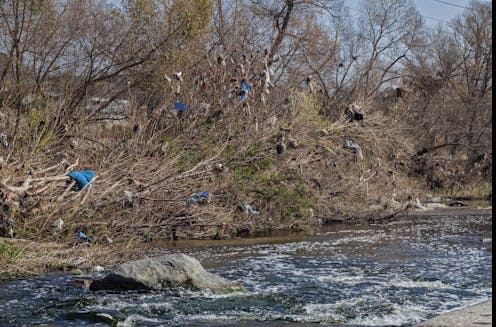If plastic comes from oil and gas, which come originally from plants, why isn’t it biodegradable?
- Written by Yael Vodovotz, Professor of Food Science & Technology, The Ohio State University

When something that is biodegradeable, like a cardboard box, breaks down, microorganisms that are present in nature break down and digest the polymers in it. They do this using enzymes[6] – proteins that help speed up the breakdown of compounds such as lignin, a natural polymer found in plant tissues.
If oxygen is present, which usually means the microbes and the thing they are breaking down are exposed to air, the polymers will biodegrade completely. Eventually, all that’s left will be carbon dioxide, water and other biological material.
Oxygen is essential because it helps the microorganisms that degrade the material live longer. Biodegradation is usually fastest in hot, wet environments where there are enough microorganisms – for example, damp leaves on the ground in a warm tropical forest.
But polymers like polypropylene are not abundant in nature. The enzymes in the microorganisms that break down biodegradeable materials don’t recognize the bonds that hold polymers together.
Eventually, the polymers in plastic waste may break down, perhaps after hundreds of thousands of years. But when it takes such a long time, the damage is already done to the environment. Plastic trash can release harmful chemicals into soil and water[7], or break into tiny bits that animals[8], fish[9] and birds[10] eat.
In my laboratory, we’re developing what we hope will be the plastics of the future[12] – materials that work like regular plastic, but don’t spoil the environment because they can degrade when people are done with them.
We work with bioplastics – materials that are made by tiny living bacteria. The bacteria make these substances for uses such as storing energy or protecting themselves from their surroundings. They can do this over and over, so we have lots of bioplastic to work with.
We blend these polymers with natural rubber, an abundant resource that comes from rubber plants, and with oil removed from waste grounds that are left over from making coffee. The rubber makes our bioplastic flexible, and we chemically modify the coffee ground oil to help make the material flow in the industrial machines that we use to shape it.
Making bioplastics isn’t cheap, because there is not enough of the different ingredients right now that go into making these materials, and it costs a lot of money to set up the equipment to make them. But when enough people want them, the price will come down. I hope that one day these new biodegradable materials will replace plastics made from fossil fuels.
Hello, curious kids! Do you have a question you’d like an expert to answer? Ask an adult to send your question to CuriousKidsUS@theconversation.com[13]. Please tell us your name, age and the city where you live.
And since curiosity has no age limit – adults, let us know what you’re wondering, too. We won’t be able to answer every question, but we will do our best.
References
- ^ Curious Kids (theconversation.com)
- ^ curiouskidsus@theconversation.com (theconversation.com)
- ^ turned them into fossil fuels (ocean.si.edu)
- ^ polymer (www.sciencenewsforstudents.org)
- ^ Bacsica.iStock/Getty Images Plus (www.gettyimages.com)
- ^ enzymes (www.britannica.com)
- ^ release harmful chemicals into soil and water (www.unep.org)
- ^ animals (blog.marinedebris.noaa.gov)
- ^ fish (www.theguardian.com)
- ^ birds (theconversation.com)
- ^ Alfonso Di Vincenzo/KONTROLAB/LightRocket via Getty Images (www.gettyimages.com)
- ^ the plastics of the future (news.osu.edu)
- ^ CuriousKidsUS@theconversation.com (theconversation.com)
Authors: Yael Vodovotz, Professor of Food Science & Technology, The Ohio State University

